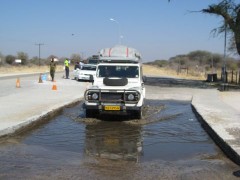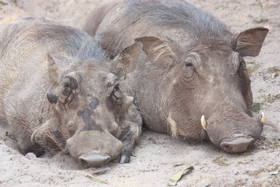Tom and Lucy's Honeymoon
Part 1 - Chobe
September 2010
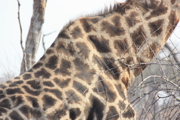
We gave her giraffes. There are always problems photographing giraffes through a telephoto lens. You have to do them in sections
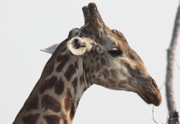
Early in September my stepson Tom married Lucy. They were married in Westonbirt arboretum on the first wet day for weeks. For their honeymoon they decided on a trip in my old Landrover in which I was the chauffeur and Santjie came along because she was good at cooking things in foil on a fire. We arranged the full southern Africa experience.
Lucy particularly wanted giraffes, We gave her giraffes
 |
At the wedding, Lucy and Eileen, the two new sisters-in-law starting as they mean to go on. Tom mediating in the background |
'In 231 kilometres, at the roundabout, take the second exit' said the Garmin lady before I turned her off. Garmin persons in the Kalahari are much the same as they are in England but operate on a rather grander scale. We were heading east from Windhoek making for Maun in Botswana
For those who don't know anything about this part of the world, Maun is at the bottom of a vast inland delta where the Okavango River sinks without trace into the Kalahari sand. At the bottom of this delta is the Thamalakane River which collects any of the remaining water which fails to sink. Maun used to be a small beautiful administrative village next to a narrow bridge over the River. Now it is a vast mess of unplanned development of the kind that the Batswana seems so good at making.
For the last 30 years or so there's been little water in the Thamalakane river at this year, for the first time in the memory of most people in Maun, it has flooded. So much so that it has washed away one of the main road bridges and, when we arrived, was overflowing into a shallow lake called Lake Ngami, which has been dry since the 1980s. By coincidence, the last time I was here was the last time it flooded; about 1982 as I recall
Here, the local people, the BaTawana, have for centuries lived off the riches of the Delta using punts called Mokoros made from hollowed tree trunks for both transport and fishing. These days they are made of plastic and they take tourists; we hired a couple with their polers, to show us a bit of the Delta from the inside.
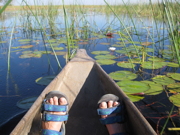
Reeds. Some with little white frogs and some without
If you're into tall reeds that you cant see over this is a fantastic experience. We soon noticed that there were two kinds of reeds, those that had little white frogs on and those that did not. We spent quite a time playing spot the frog because the general idea of the trip was to take us to one of the islands where we could do a walkabout and be eaten by crocodiles and charged by elephants. The problem was that the high water level meant that all the nearby islands had disappeared and the punt trip was, they explained, a bit longer than normal.
How our polers knew where they were among this vast flat area of reeds, remains a mystery but they did, and they eventually delivered us to an island, complete with an elephant and a baobab tree as well as a few other things such as zebra and gnu. The elephant, as usual, was invisible until our poler pointed out. But its droppings were not; they were everywhere and I added several golf ball sized palm fruits to my collection of things-which-have-passed-unchanged-through-an-elephant.
We saw a lot of birds but usually just a flash above our reeds and then they were gone. Two kingfishers of course, the pied and the giant and a fine Senegal Coucal. The birds presented our polers with a bit of a problem; they knew the names of the big ones and the colourful ones but the majority were just 'others' and our poler eventually took to pretending he did not hear our questions. But the big birds were interesting and and an exciting sighting was the Marsh Harrier, rare even here where it doesn't have royalty with their popguns to worry about. And, of course, the call of the Fish Eagle is the defining sound of the Okavango much in the way as the curlew is the defining sound of our northern uplands in Britain. |
Lucy's first elephant, Taken with her camera, a lone male paddling around in the wilderness. Blink an eye and it disappears. |
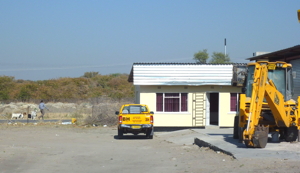 |
JCB Maun The 130 km roadworks we hit between Maun and Kasane gave him an opportunity to assess the penetration of the African market |
The Batswana make dirty holiday-makers disintect themselves periodically at road blocks.
Click on this image for a second tedious picture of us disinfecting ourselves. (This uses a neat little bit of script called Lightbox)
From Maun we went to Chobe Lodge, made famous in 1975 by experienced honeymooners Richard Burton and Elizabeth Taylor, who spent their second here. In those days you normally flew to places like this. Just a few years later I drove there in my new Ford Escort 1600DL (cream with a simulated leather roof), two long days driving from Gaborone. The dirt roads were levelled periodically by bush drags, a small tree pulled by a tractor. It was in the days before we thought four-wheel drive was needed in Africa and often had to dig yourself out. But we did not stay at the lodge then because we were not millionnaires. And it certainly did not cater for campers. Things have changed a bit since then. |
Chobe lodge is still a favourite for honeymooners |
A Sable antelope - Click on it for more
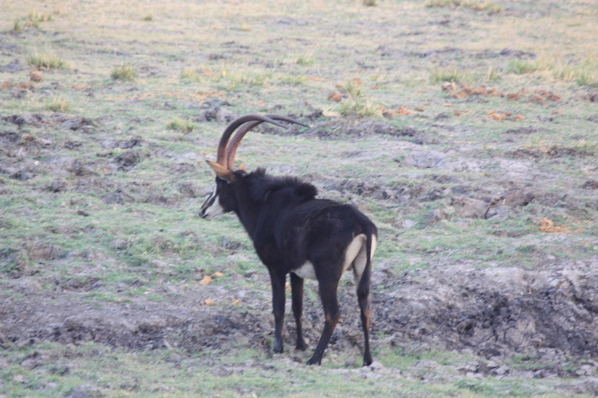
Back in the seventies you just drove into Chobe Park and camped at one of the designated spots. You kept the fire going all night to deter lions and you locked all food in the car. Banded mongooses used to chew their way into the tent if they could smell anything interesting, shoes left outside were taken by jackals and any loose camping equipment strewn around the bush by baboons. And you always reversed towards elephant. Most of the tracks were suitable for normal cars as long as you took care not to puncture your sump on a protruding rock. Its different now.
These days you can still camp in the park in an expensive organised site behind a high fence but the tracks are no longer maintained because everyone has four-wheel drive. Its easier, and cheaper to stay outside the park and be taken in on an official game drive. We squeezed into Chobe Lodge Campsite.
There are a few registered game drive companies and they take Landcruisers full of people in at dawn each day into the Park. They all work together informing each other by radio of interesting sightings. The first thing they do each morning is play Spot the Lion. As soon as one is spotted all the vehicles converge at high speed on it to provide photo ops of a group of lions completely encircled by tourists, the Japanese group clearly distinguishable by their little white facemasks to keep out African dust.
After that you can just sit back and enjoy Africa and take lots of distant out-of-focus pictures of bits of bush in which there is, or was, an animal. Click on the Sable on the left for an interminable gallery of such photographs.
The other thing you do at Chobe Lodge is go for a boat ride. You join hundreds of others in a whole flotilla which heads for the island in the Chobe in the hopes of getting so far up the trunks of the elephants there that they start snorkeling back to the mainland. The island is interesting as a few years ago it nearly led to a little local war between Namibia and Botswana when the river was so low that farmers could cross with their cattle from the Namibian side. The EU was asked to mediate and researchers came up with some kind of historical proof that the colonial border was the South West Africa channel not the Bechuanaland channel. There is now a big blue Botswana flag in the middle of it. |
More animal photos for the those who enjoy such things. Click on the picture.
|
Click on the picture for some more Chobe birds
|
Four legs good, two legs better. Santjie and I have just about done the animals and we have started on birds. These have a number of advantages, there are more of them, more different species, they are nicer colours and they are less of an effort; you can just sit around and they come to you. So I bought myself a monopod for the camera. This means that the pictures with the telephoto are only slightly, instead of completely, out of focus. So on the left are a few pictures of birds that were hanging around Chobe. I think I have identified them correctly. The words 'common resident' in the book is usually the clincher. |
To follow later - Part 2, Victoria Falls and Etosha
|


